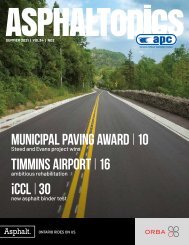ASPHALTopics | Summer 2014 | VOL 27 | NO3
You also want an ePaper? Increase the reach of your titles
YUMPU automatically turns print PDFs into web optimized ePapers that Google loves.
ENVIRONMENTAL<br />
ESSENTIALS<br />
by Adam Draper<br />
The road to air permits:<br />
How did we get here?<br />
In light of the 40th anniversary of OHMPA and as<br />
an environmental consultant on the Asphaltopics<br />
subcommittee, I was asked to write a brief history of<br />
air permitting in Ontario over the past 40 years. Well<br />
what a coincidence! I discovered that just as OHMPA<br />
was born in 1974, so too was the entity known as the<br />
Ontario Ministry of the Environment!<br />
Now this is not to say that there was no environmental<br />
legislation prior to 1974. In fact, well before this date<br />
a Select Committee was appointed to investigate air<br />
pollution in Ontario. As a result of their 1957 report<br />
entitled Report on Air Pollution and Smoke Control,<br />
the Air Pollution Control Act was passed in 1958.<br />
Unlike today where environmental legislation is the<br />
enacted by the province, in 1958 municipalities controlled<br />
air pollution according to by-laws. The role of the<br />
provincial government was solely as an advisory body.<br />
However, between 1958 and 1963 only a portion of the<br />
municipalities actually passed air pollution control by-laws.<br />
Many municipalities did not want to hurt their industrial<br />
growth, particularly compared to other municipalities<br />
that did not implement similar by-laws.<br />
To address this issue, the Air Pollution Control Act<br />
was amended in 1963 with the province assuming<br />
full management of industrial sources of air pollution.<br />
Although this marks the advent of a formalized permit<br />
system, the fledgling act did not include any fixed numbers<br />
or standards. Needless to say, the new province-wide<br />
system was ineffective at reducing air emissions – in<br />
general, industry’s “innovative solution” was to build<br />
taller stacks to disperse emissions further away!<br />
Industry’s approach did not go unnoticed. As environmental<br />
activism gained momentum in the late 1960s,<br />
environmental groups and the public demanded reform.<br />
Ontario’s response was the Environmental Protection Act<br />
which was enacted in 1971, along with the creation of one<br />
full-time ministry in charge: the Ontario Ministry of the<br />
Environment (MOE).<br />
The first job at hand for the newly formed MOE was to<br />
figure out where to go by understanding the starting<br />
point. So, throughout the 1970s the MOE worked to<br />
create a database and record the current state of the<br />
environment. Armed with this knowledge, new regulations<br />
were passed. For example, the Ontario Regulation 308<br />
(Air Pollution) passed in 1980 included specific maximum<br />
concentrations for air contaminants.<br />
Since this time, the MOE has gathered with industry<br />
and stakeholders approximately every ten years to review<br />
environmental legislation. These meetings have resulted<br />
in two significant revisions to air pollution regulations:<br />
Ontario Regulation 346 (1990) and most recently Ontario<br />
Regulation 419 (2005). These revisions have changed a<br />
fairly simple assessment process and one-page permit<br />
into the significantly more complex application process<br />
and multi-page permit that OHMPA’s members are familiar<br />
with today.<br />
What does the future hold? Most likely ever tightening<br />
regulation which industry must be prepared to meet.<br />
Luckily for you, OHMPA’s Environment Committee has<br />
and continues to work hard on your behalf to help you<br />
navigate smoothly through environmental legislation while<br />
paving the way towards environmental excellence.<br />
Adam Draper is an environmental scientist and aggregate<br />
specialist at BCX Environmental Consulting, a Canadian<br />
environmental engineering company specializing in<br />
providing expert air quality services.<br />
With special credit to Paul Complin, Principal, Compliance<br />
and Permitting, ORTECH<br />
FALL <strong>2014</strong> 65


















